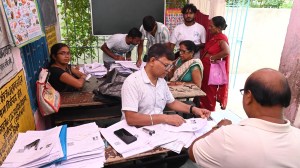Obese at hip? PGI study says at higher risk of diabetes
Obesity is a prevalent health issues and is associated with a range of metabolic abnormalities, including decreased glucose tolerance, reduced insulin sensitivity, and adverse lipid profile, which are risk factors for cardio-metabolic diseases — Type 2 diabetes, hypertension and Atherosclerotic Cardiovascular Disease (ASCVD). Obesity can be sub-classified as abdominal, generalised and a combination of two. […]
 A study was conducted by the Departments of Endocrinology and Biochemistry, PGIMER, titled, ‘Abdominal obesity and incident cardio-metabolic disorders in Asian-Indians: A 10-years prospective cohort study’. (Express file photo)
A study was conducted by the Departments of Endocrinology and Biochemistry, PGIMER, titled, ‘Abdominal obesity and incident cardio-metabolic disorders in Asian-Indians: A 10-years prospective cohort study’. (Express file photo)Obesity is a prevalent health issues and is associated with a range of metabolic abnormalities, including decreased glucose tolerance, reduced insulin sensitivity, and adverse lipid profile, which are risk factors for cardio-metabolic diseases — Type 2 diabetes, hypertension and Atherosclerotic Cardiovascular Disease (ASCVD).
Obesity can be sub-classified as abdominal, generalised and a combination of two. Many measures have been used to assess these subtypes including body mass index (BMI), waist circumference, waist-hip ratio, and waist-height ratio. Among these, waist circumference which assesses abdominal obesity is a more important predictor for future cardio-metabolic events compared to excess weight as assessed by BMI. Given the importance of abdominal obesity in predicting cardiometabolic complications, in Asian-Indians, WHO recommends a waist circumference cut-off of 90 cm and 80 cm in men and women, respectively, for defining abdominal obesity.
A study by the Departments of Endocrinology and Biochemistry, PGIMER, titled, ‘Abdominal obesity and incident cardio-metabolic disorders in Asian-Indians: A 10-years prospective cohort study’, aimed to estimate the strength of association between abdominal obesity and incident dysglycemia, hypertension and ASCVD. A subset of Chandigarh Urban Diabetes study cohort (543) was followed after 10.7 years for development of diabetes, prediabetes, dysglycemia, hypertension and ASCVD.
Compared to non-obese (209), abdominally obese individuals (334) had a higher risk of diabetes, prediabetes, dysglycemia, hypertension, and ASCVD. The optimal cut-off of waist circumference for detecting incident diabetes, hypertension and ASCVD in females was 88 cm, 85 cm and 91 cm, respectively; while in males it was 90 cm, 87 cm and 94 cm, respectively.
“Abdominal obesity, as defined by WHO cut-off of waist circumference in Asian-Indians, was associated with a nearly two times higher risk of diabetes, ASCVD and hypertension. This higher risk was seen despite abdominally obese individuals having significant improvement in physical activity and decrease in waist circumference overtime.
In addition, an increment of 2 cm in waist circumference over 10 years predisposed individuals for incident dysglycaemia and hypertension,” says Dr Ashu Rastogi, Associate Professor at PGI’s Department of Endocrinology.
Waist circumference, he says, is a measurable estimate for assessing abdominal obesity, making it a useful tool for widespread use. However, he adds, there are limitations of applying uniform waist circumference cut-off to assess the cardio-metabolic risk in individuals globally as there is a significant difference in body composition among different ethnic groups. “Hence, the prevalent waist circumference cut-off for defining abdominal obesity in Asian-Indians needs reconsideration in the light of the results of the present study. Abdominal obesity increases with advancing age due to physical inactivity, hormonal alteration, associated comorbidities, and central redistribution of fat. An increment in waist circumference is a predecessor for incident metabolic disorders, which occur at lower waist circumference in Asian-Indians as compared to Caucasians. In the current study, a gain of 2.2 cm and 2.1 cm in waist circumference over 10.7 years predisposed to incident diabetes and hypertension, respectively,” explains Rastogi.
Dr Anil Bhansali, former head, Department of Endocrinology PGIMER, says at present, the risk of diabetes is increasing rapidly even in young people, with many diagnosed between the ages of 20 and 40. This is unlike Western countries, where diabetes typically manifests after the age of 60. The reasons for this include a genetic predisposition and lifestyle factors like modern-day stress, a sedentary routine, reliance on fast food, and a lack of regular exercise.
“In Chandigarh, the prevalence of diabetes is 20.4 per cent and apart from an unhealthy diet, lack of sleep, inadequate physical activity are also contributing to the high numbers,” adds Bhansali.







